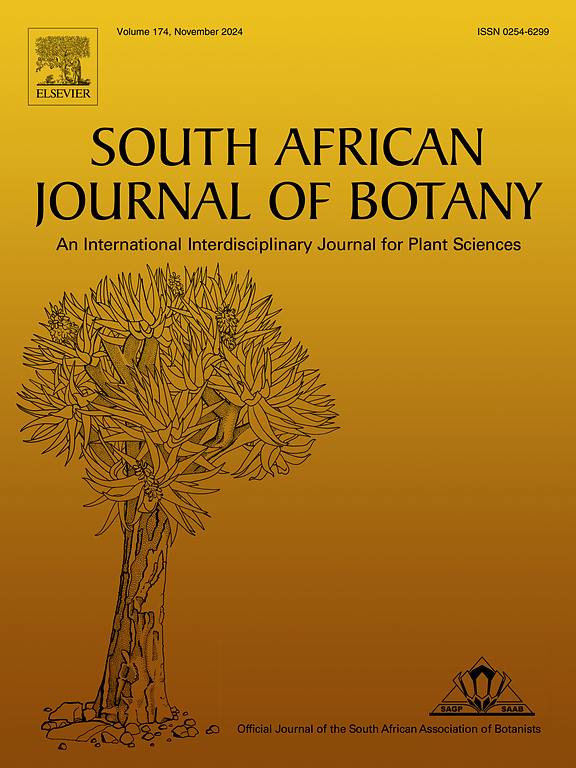在吡喹莫德诱导的银屑病样皮肤炎症模型中,生物技术生产的原甘草提取物的抗银屑病活性
IF 2.7
3区 生物学
Q2 PLANT SCIENCES
引用次数: 0
摘要
牛皮癣是一种自身免疫性慢性疾病,有效和长期的治疗方法仍在开发中。对治疗方法的探索包括对植物提取物的探索。其中,原丘柏(Harpagophytum procumbens, Burch.)直流。Meisn交货。由于其抗炎特性,传统上用于治疗关节炎和其他炎症状况。利用生物技术方法作为可持续生产植物源性生物活性化合物的手段,本研究在咪喹莫特(IMQ)诱导的银屑病样皮炎小鼠模型中评估了含有原棘毛根提取物(HPE)的局部配方的抗银屑病潜力。通过优化的潜水培养法制备HPE。利用核磁共振(NMR)和高效液相色谱(HPLC)进行代谢物谱分析,鉴定毛蕊花苷(VER)和白藜芦醇苷A (leucosceptoside A)为主要的次级代谢物。皮肤源性细胞和脾脏t淋巴细胞的流式细胞分析显示,HPE和VER均未改变t淋巴细胞群,但调节趋化因子受体3 (CXCR3)、转化生长因子β受体1 (TGFβRI)表达和促炎细胞因子丰度(IFN-γ和IL-17F)。为了评估其治疗活性,将HPE掺入外用乳剂中,并应用于imq诱导的牛皮癣样皮炎小鼠。组织学评估和适应银屑病面积和严重程度指数(PASI)的形态学评分显示,5% HPE乳膏可显著减少银屑病皮损,包括结垢、红斑和表皮增厚。这些发现表明生物技术生产的HPE对局部银屑病特征具有保护潜力。本文章由计算机程序翻译,如有差异,请以英文原文为准。

Anti-psoriatic activity of biotechnologically produced Harpagophytum procumbens extract in an imiquimod-induced psoriasiform skin inflammation model
Psoriasis is an autoimmune chronic disease for which effective and long-term therapy remains under development. The search for therapeutic solutions includes the exploration of plant extracts. Among these, Harpagophytum procumbens (Burch.) DC. Ex Meisn. is traditionally used for treatment of arthritis and other inflammatory conditions, due to its anti-inflammatory properties. Utilizing biotechnological approaches as sustainable means for production of plant-derived bioactive compounds, the present study evaluates the anti-psoriatic potential of a topical formulation containing H. procumbens (Devil’s claw) hairy roots extract (HPE) in an imiquimod (IMQ)-induced psoriasis-like dermatitis murine model. The HPE was produced through optimized submerged cultivation. Metabolite profiling was performed using nuclear magnetic resonance (NMR) spectroscopy and high-performance liquid chromatography (HPLC), identifying verbascoside (VER) and leucosceptoside A (LEU) as the predominant secondary metabolites. Flow cytometric analysis of skin-derived cells and spleen T-lymphocytes revealed that neither HPE nor VER altered T-lymphocyte populations but modulated chemokine receptor 3 (CXCR3), transforming growth factor beta receptor 1 (TGFβRI) expression, and pro-inflammatory cytokines abundance (IFN-γ and IL-17F). To evaluate its therapeutic activity, HPE was incorporated into a topical emulsion and applied to mice with IMQ-induced psoriasis-like dermatitis. Histological assessment and morphological scoring of the adapted psoriasis area and severity index (PASI), demonstrated that the 5 % HPE cream significantly reduced psoriatic skin lesions, including scaling, erythema, and epidermal thickening. These findings indicate the protective potential of biotechnologically produced HPE for local psoriatic features.
求助全文
通过发布文献求助,成功后即可免费获取论文全文。
去求助
来源期刊

South African Journal of Botany
生物-植物科学
CiteScore
5.20
自引率
9.70%
发文量
709
审稿时长
61 days
期刊介绍:
The South African Journal of Botany publishes original papers that deal with the classification, biodiversity, morphology, physiology, molecular biology, ecology, biotechnology, ethnobotany and other botanically related aspects of species that are of importance to southern Africa. Manuscripts dealing with significant new findings on other species of the world and general botanical principles will also be considered and are encouraged.
 求助内容:
求助内容: 应助结果提醒方式:
应助结果提醒方式:


